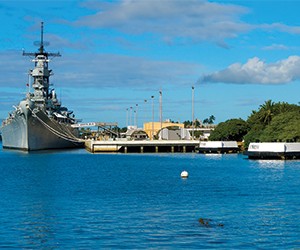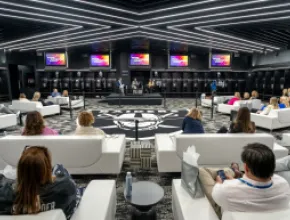While justifiably celebrated for its balmy climate, beautiful beaches and five-star resorts, those attributes are not what make Hawaii truly unique as a meetings destination. There’s also something called aloha—a word that is not just a greeting, but one that refers to Hawaii’s cultural values and gracious spirit—that makes for memorable experiences for leisure and business guests alike.
“We have many testimonials from attendees telling how the aloha spirit impacted the meeting and themselves,” says Randy Tanaka, assistant general manager of the Hawaii Convention Center. “We are a place where business is enhanced. People come away from Hawaii with a lasting experience—in fact, some of our clients say it was life changing.”
Michael Murray, vice president of sales and marketing for the Corporate, Meetings and Incentives division of the Hawaii Visitors and Convention Bureau (HVCB), adds that Hawaii is increasingly emphasizing its aloha spirit and traditions as a way to set itself apart from other destinations.
“Most people know that Hawaii has great weather, resorts, infrastructure, and hospitality, but many planners are looking for even more,” he says. “We’re different because of our language, history, surfing, and all the other elements that make up aloha. Sharing these values with customers is important. It’s how we set ourselves apart.”
Cheryl Williams, regional vice president of sales and marketing for Starwood Hawaii, says meeting planners have come to expect that a “sense of place” will be part of a Hawaii meeting, adding that this ties in with general visitor trends.
“According to research conducted by the HVCB in 2006, more than 75 percent of our visitors participate in Hawaiian cultural activities while visiting the islands,” she says. “This can also be translated to MCI [meeting, convention and incentive] visitors. Now more than ever, meeting planners have expressed interest in what the destination has to offer, from culture to island cuisine, allowing attendees to experience the diverse multicultural heritage that makes Hawaii so unique.”
With Hawaii in the midst of a cultural renaissance reflected in everything from the way resorts are being redesigned to a burgeoning celebration of traditional dance and music, the opportunities to inject some aloha spirit into a meeting are practically unlimited, Murray notes.
“Planners can tap into Hawaiian culture in very creative ways,” he says. “Even a physical activity such as canoe racing can be part of the aloha experience. You can do things like a sunset reception on the beach, where the CEO arrives in an outrigger canoe dressed as a Hawaiian warrior. It’s a dramatic way to kick off a meeting.”
Business with Aloha
While often thought of as primarily serving an entertainment purpose, Hawaiian cultural traditions can also play a role in furthering the business objectives of a meeting. Hawaiian cultural experts, who are increasingly contracted by major resorts to serve in advisory roles, can lead team-building programs based on island traditions and serve as motivational speakers.
An important resource in this regard is the HVCB’s new Hawaii Speakers Bureau, which represents over 20 Hawaiian business leaders and cultural experts, including David Cole, CEO of the Maui Land & Pineapple Co. and an expert in agricultural sustainability; Peter Apo, founding member of the Native Hawaiian Hospitality Association; Robert Retherford, coordinator of population and health studies at the East-West Center; Walter Dods, chairman of First Hawaiian Bank; and Ramsay Taum, developer of a cultural training program used in hotels and tourism organizations throughout Hawaii.
According to Murray, one of the objectives of the new speakers bureau is to offer groups the opportunity to gain perspectives on contemporary issues involving Hawaii and the Pacific Rim.
“Hawaii has leaders who have made their mark in the world and we’re fortunate they are willing to share their knowledge with groups doing business in the islands,” he says. “And the bureau is a great resource for planners who are looking to incorporate cultural elements into their programs.”
Blending Hawaiian cultural traditions with business objectives is something that Clifford Naeole frequently does in his capacity as Hawaiian cultural advisor at The Ritz-Carlton, Kapalua on Maui.
“I see groups coming into Hawaii with a rigid schedule—and all too often they leave just seeing what’s on the surface,” he says. “My job is to create a bridge by helping the hotel put a sense of aloha into the meeting. We want to share our knowledge.”
Naeole frequently gives groups “Sense of Place” tours of the property—which borders an ancient burial ground—that include everything from Hawaiian history to the use of native plants for medicinal purposes.
He also designs team-building programs that get groups out into the local community. In a recent program, a corporate group was divided into three teams, one assigned to work with kids at a Hawaiian language school, one assigned to help renovate a temple and another assigned to help restore an outrigger canoe.
“It created a bridge between the corporation and the local community. It was a way for people to learn about each other,” Naeole says. “It had educational value for both sides. The group was very moved—they realized we are more than aloha shirts and mai tais.”
Naeole also gives a business presentation called “First Canoe,” which uses the launching of a canoe voyage as an analogy to reaching business goals.
“It’s a cultural and spiritual lesson that addresses the questions of how do we get there, how do we get along,” he says. “When you work together to paddle the canoe, it moves forward.”
Resorts with Aloha
Increasingly, resort hotels in Hawaii are working to create an atmosphere of aloha through their design, amenities and cultural programs for guests, including groups. One result of this is seen in the way some resorts, which were originally built in a formal, non-Hawaiian design, are undergoing substantial makeovers more in keeping with their surroundings.
One of the most dramatic transformations can be seen in the recent $160 million renovation and redesign of The Ritz-Carlton, Kapalua, which has gone from a traditional Ritz-Carlton look with marble and European-style furnishings to a Hawaiian-style design utilizing native stone, woods and landscaping.
Similarly, Kauai’s Princeville Resort, which is closing down in September for a major makeover, is expected to emerge with a much more Hawaiian look and feel when it reopens in May 2009 as part of Starwood’s St. Regis brand.
At some resorts, the lobby and public spaces are being redesigned to showcase artwork and artifacts reflecting their Hawaiian locale. The new lobby at the Outrigger Reef on the Beach in Waikiki, part of the hotel’s $100 million makeover, features dramatic paintings of canoe voyages, a small library of Hawaiian literary works and cases filled with museum-quality artifacts such as canoe ornaments and bowls made of Hawaiian woods. The hotel has also introduced Steel Guitar Sundays, during which some of Hawaii’s most acclaimed steel guitarists play this locally popular instrument at the Shore Bird Restaurant and Beach Bar.
Also in Waikiki, the Hilton Hawaiian Village recently unveiled its Ohana Library and Reading Room, a space where guests can enjoy a collection of books, DVDs and CDs related to Hawaii and the Pacific Rim. The hotel has also unveiled a year-long renovation of its five-acre Duke Paoa Kahanamoku Lagoon, named for the famed Olympic swimmer who is considered the father of modern surfing, which now features a new saltwater circulation system and landscaping.
The rejuvenated lagoon is the focus of the Hilton’s new “Surfing 101” program, a traditional Hawaiian talk-story session that can be customized for groups. The session is led by Kaai Bruhn, a champion canoeist, who speaks on Kahanamoku’s life and times, and includes a surfing demonstration by one of Waikiki’s most celebrated surfers.
At Honolulu’s upscale Kahala Hotel, the aloha spirit is part of new meeting breaks called Gifts of Hawaii, which are led by Hawaiian “aunties,” older women who are authorities on various traditional crafts and cultural experiences. Along with sampling island specialties such as taro chips and guava cake, attendees are led through basic hula moves and chanting exercises.
Both Starwood Hawaii and Marriott Resorts Hawaii, companies with multiple properties on the four major islands, have developed aloha-inspired programs in various forms at their resorts.
“The customs and traditions of our host culture are interwoven into many aspects of the meetings experience, including cultural programs such as lei making and Hawaiian storytelling, cuisine prepared with ingredients from local farmers and fishermen, and entertainment by local hula halau and musicians,” says Williams at Starwood Hawaii, which calls its cultural program “In Celebration of Aloha.”
Starwood’s team-building programs include the Sheraton Keauhou’s “Heiau” exercise that is inspired by the heiau, an ancient stone structure frequently found along the Kona coast near the resort. Attendees group together to build their own heiau structures using volcanic rocks according to Hawaiian traditional practices.
The Sheraton Kauai has partnered with students from Kauai High School Academy of Hospitality & Tourism to develop and implement cultural activities into the resort’s programs. The activities, originally intended for teens but now popular with guests of all ages, include Hawaiian language lessons, traditional games, scavenger hunts, and poi pounding.
At Marriott properties, a new program called Authentic Hawaiian Experiences for Group Meetings has offerings at all five resorts in the islands.
At Maui’s Wailea Beach Marriott Resort, cultural advisors Ramsay Taum, Clifford Naeole and Lyons Naeole have designed team-building exercises and events such as a welcome blessing, in which guests are greeted by a conch shell blower who escorts them to the reception. A group from Allstate recently participated in an event where they learned to make a traditional drum from coconut palm materials.
On the Big Island of Hawaii, the Waikoloa Beach Marriott has a menu of activities for groups that include stargazing at the summit of the 13,796-foot-high Mauna Kea and beach bonfire gatherings that feature a cultural expert, who shares stories about Hawaiian legends such as Pele the Hawaiian goddess of fire.
For More Info
Big Island Visitors Bureau 808.961.5797
www.meetbigisland.com
Destination Lanai 808.565.7600
www.visitlanai.net
Hawaii Visitors and Convention Bureau 808.923.1811
www.meethawaii.com
Kauai Visitors Bureau 808.245.3971
www.kauaidiscovery.com
Maui Visitors Bureau 808.244.3530
www.visitmaui.com
Molokai Visitors Association 808.553.3876
www.molokai-hawaii.com
Oahu Visitors Bureau 808.524.0722
www.visit-oahu.com







